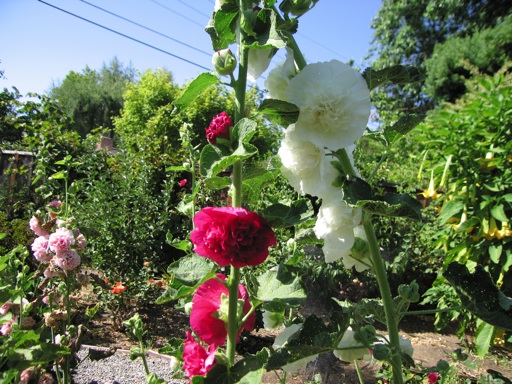
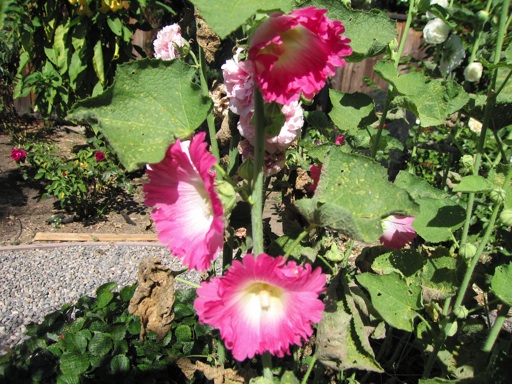
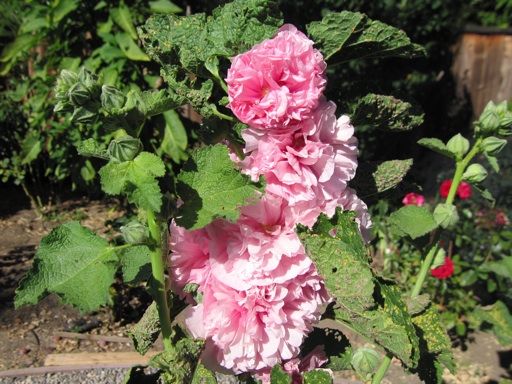
We are growing biennial hollyhock flowers in one our raised beds again this year. Last spring, I planted about a half a dozen double flowered hollyhock plants that I bought from a nursery. We also have single flower hollyhock varieties that reseeded on their own from last year’s hollyhocks.
The flowers are beautiful, but the leaves look messy. Their upper leaves are full of yellow spots, and most of their lower leaves have turned brown and died. I suspect the problem is a disease called hollyhock rust. The hollyhocks that are growing together in a group of about 8 plants seems to have much more of the disease than the few hollyhocks I have growing on their own in other parts of our garden. I don’t want to spray fungicide on them, because I have them growing near vegetables. So I will just pull them out as they die back later in the summer.
July 15 2012 | Hollyhock | Comments Off on Hollyhocks
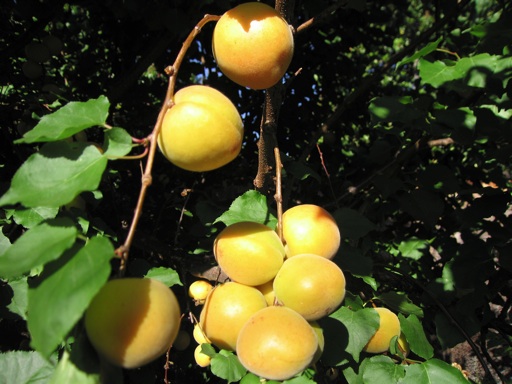
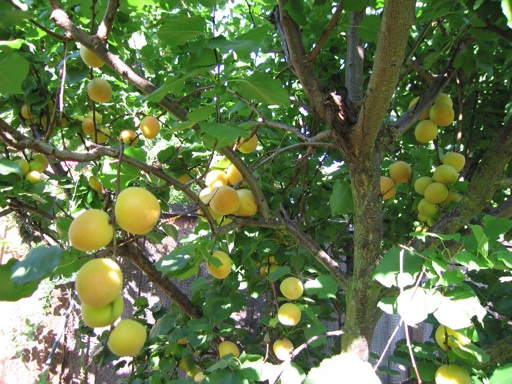
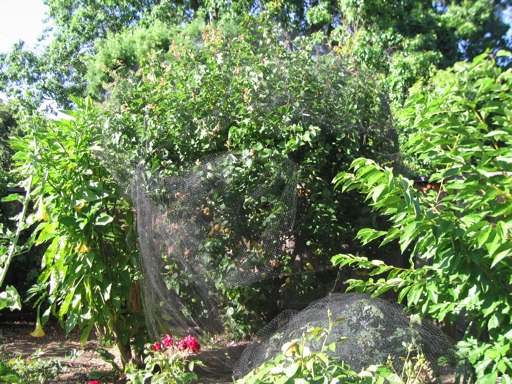
This season, our 10 year old Blenheim apricot tree has produced hundreds of apricots. It’s the same Blenheim apricot tree I blogged about in prior posts. The layers of netting wrapped around the sides, top and bottom of the tree kept out most of the critters. However, earwigs have gotten into several of them. Last weekend, I put a cardboard strip with tanglefoot around the trunk of the tree to deter the bugs from crawling up the tree at night. It seems to have helped.
I have already picked about half of the crop, and there is still over 100 unripe fruit left on the tree. Our home grown apricots are delicious as fresh fruit. But my favorite way to eat them is in an apricot crisp. Apricot crisp is a baked dessert of apricots and sugar covered with a butter crumble topping. It’s the best fruit pie in my opinion, the perfect balance of sweet and tart.
Last year, our apricot tree didn’t produce a single fruit, which I blame on the heavy rains that occurred during its bloom time. Heavy rains can damage apricot blossoms. Last March, forecasters predicted heavy rains again while our tree was in full bloom. So I covered the tree with a plastic sheet to protect the blossoms from damage. I have a picture of it covered in plastic in an earlier post on this blog. It seems to have worked.
After 10 years, this tree is in its prime. It grows very rapidly. It would grow about 4-6 feet or more per year in all directions if it weren’t for the fact that I prune it about 3 times a year. Typically, I prune once in January, once in early June just before netting it, and again in July or August after the fruit comes off. Keeping it a reasonable size makes the tree so much easier to net and to harvest the fruit. Between the pruning, netting, fertilizing, and picking, apricot trees (and fruit trees in general) can be a lot of work. But I enjoy the process, and I certainly enjoy the harvest.
July 07 2012 | Apricots | Comments Off on Apricots
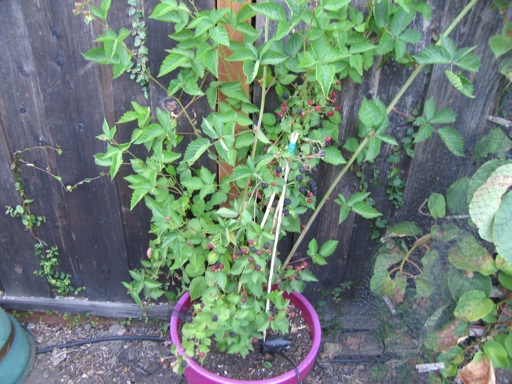
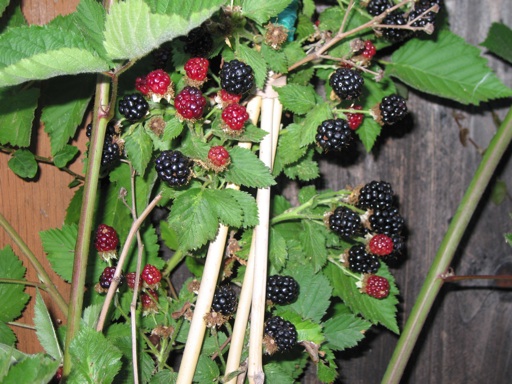
Last summer, I discovered this blackberry plant at a local nursery. It’s a thornless blackberry variety called Navaho. I planted it in a container with a standard potting soil, and I put the container next to a fence to help support its vines. Its vines are more erect then the vines of my raspberry plants (which I am also growing in containers) and do not seem to need much support. I have an automatic microspray device on it that waters it every other day.
Wild blackberries grow in some parts of our yard, and I am constantly digging them up in an attempt to get rid of them. The thorns on these wild blackberries are nasty. They poke right through my thickest gloves. So I was excited to discover that there are hybrid varieties of thornless blackberries. What a pain it is to harvest berries from thorny vines while constantly getting poked! I didn’t even consider planting blackberries until I discovered this thornless variety. It turns out there are several other thornless blackberry varieties.
The wild blackberries in our yard are invasive. They spread by underground runners, which makes them hard to control. I have tried pulling them up by the roots several times, but they keep growing back every year. I decided to plant the Navaho blackberry in a container, in order to prevent it from spreading the way blackberries tend to do.
Navaho is an early ripening variety. Most of its berries are ready to be picked in late June and early July. I do not like tart blackberries, but I’ve found there is a way to harvest sweet blackberries. The berries are ripe and very sweet when they come off the vine easily with only a slight tug. The berries on my Navaho are usually quite tart until they come off the vine easily. Then they are really sweet, tasting the way blackberries are supposed to taste. If I need to pull firmly to get a blackberry off the vine, it usually too tart.
I rarely buy blackberries in supermarkets, because they are typically too tart for my tastes. I’ve noticed that the sweetest of our blackberries are often soft and sometimes even on the verge of falling apart. Soft berries probably don’t ship well, and I imagine that’s why supermarket blackberries are picked early when they are very firm but tart. More reason to grow your own.
July 01 2012 | Blackberries | Comments Off on Thornless Blackberry in a Container
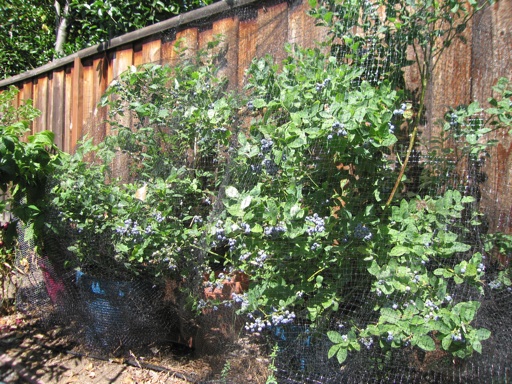
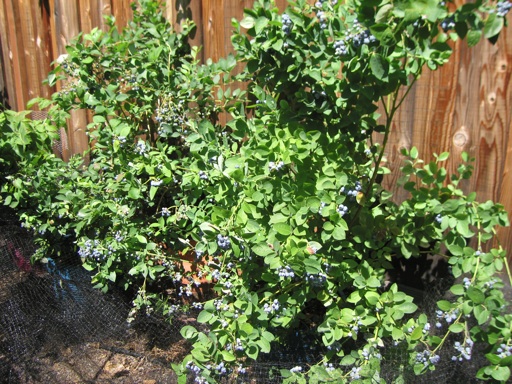
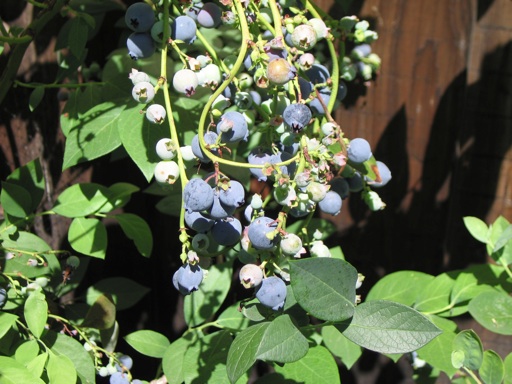
I have been growing blueberry plants in our backyard for about five years. Our blueberry harvest season runs from mid-May to late July, with June being the peak of the harvest. Every year they have been producing more berries. This morning, I harvested about 3 pints of blueberries just from the two plants in the pictures above.
All of our blueberry plants are covered with netting to reduce the number of berries that the birds eat. Each plant is covered with 3-4 layers of netting, because birds will eat through just one or two layers of netting.
My favorite way to grow blueberries is in pots. I transplanted the two plants shown in the pictures above into pots about 3 years ago. I planted them in a potting mix of about 1/3 bark, 1/3 peat moss, and 1/3 acid potting mix per Dave Wilson’s suggestion, and they have been growing and producing well. Although, the blueberry plants I have in the ground are growing and producing well too. I like growing them in pots though, because they are easier to net and harvest (less squatting). Also, growing them next to a fence makes netting a bit easier.
I am growing five different Southern Highbush varieties of blueberries that are adapted to mild winter climates. The five varieties I have are Southmoon, Jubilee, O’Neal, Sunshine Blue, and Misty. I have one plant of each variety. The two plants shown in the pictures above are Southmoon and Jubilee. My favorite varieties are Southmoon and O’Neal. My Southmoon and O’Neal plants produce the largest and tastiest berries of the 5 plants I have. My Jubilee plant produces the most berries, but they tend to be small and on the tart side, and they start to wrinkle if left on the plant too long. Misty also produces lots of small berries, although some of them are medium size.
Sunshine Blue is my third favorite variety. Its berries are a variety of sizes (large to small), and they taste very good if they are not picked too soon. Typically, the berries of all 5 varieties (particularly Misty, Sunshine and Jubilee) have to be left on the bush for several days after turning blue before they reach an ideal sweetness. Also, Sunshine Blue is a late ripening blueberry. It ripens throughout July in our yard, which is nice because it extends the harvest season an extra month.
June 16 2012 | Blueberries | Comments Off on Blueberry Harvest
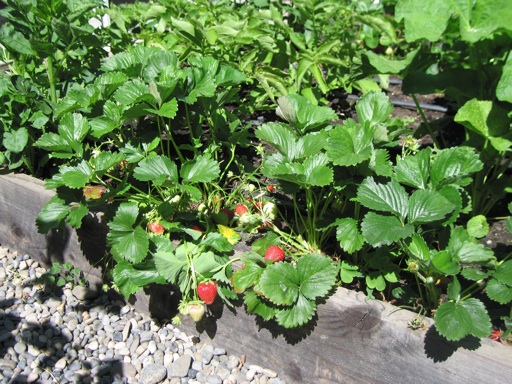
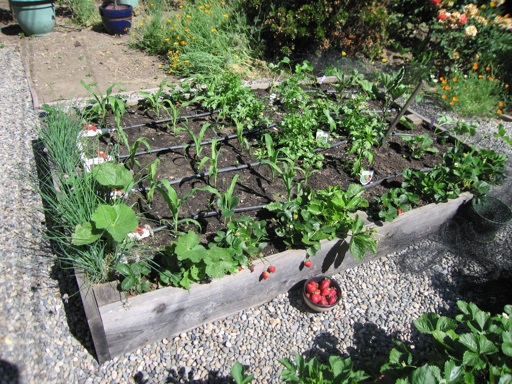
When I last posted about strawberries back in 2009, I was still growing most of our strawberries in pots. Back then, I was having problems with slugs eating the berries at night and hiding under the pots in the daytime. Copper tape and beer didn’t stop them. So over the past few years, I have been phasing out the berries growing in pots. Last year, I planted new strawberry plants as a border around each of our 4 raised beds. I planted the varieties Sequoia, Seascape, and Chandler.
They didn’t produce many berries their first year. However, starting around May 1 this year, they finally started producing a lot of berries. I have been harvesting about 4 pint size bowls of berries per week for each of the past 3 weeks. The most productive variety by far this year is Chandler. Our Chandler strawberry plants are producing many large berries, from only about a dozen plants. The Chandler berries are large and firm and don’t rot or turn brown quickly (first picture above). I have been fertilizing our strawberries about once every 2 weeks.
I have at least two dozen Sequoia strawberry plants. The Sequoia strawberries have lots of leaves, but they haven’t been as productive as the Chandler strawberries. I am not sure why the Sequoias haven’t been producing as much as they did in the past when I grew them in pots. I still have a few newer Sequoias in pots, and they aren’t producing many berries either. Also, the Sequoia berries tend to be small (many of them are very small) and often the berries start to turn brown or rot on one side before they are fully ripe. In my opinion, the Sequoia strawberries have the best flavor of these three varieties, assuming they are fully ripe, not too small, and not browning yet, which eliminates at least half of the harvest.
For now, Chandler is my favorite variety. I prefer plants that produce lots of large berries as opposed to few small ones. Just this week, I planted more Chandler strawberries plants that I purchased from a local nursery.
The Seascape strawberries are large and firm like the Chandler strawberries, but they haven’t been as productive as Chandler. Seascape is an ever bearing variety, which tends to produce more berries in the summer. Chandler and Sequoia are long day varieties, which tend to produce the most berries from mid-spring to early summer.
As for the slugs and snails, they still eat a few of the berries in the raised beds, but it’s easier to protect them with Sluggo and netting than when they were crowded into pots.
May 20 2012 | Strawberries | Comments Off on Strawberries
« Prev - Next »












